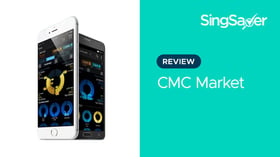Grab Financial Group (GFG) is looking to have consumers’ personal finance thrive in spite of woeful times. But how relevant are these products for you, Grab user or not?
Financial services should be as accessible as ordering from GrabFood from the comfort of your home. At least, that was the sentiment being conveyed as Grab Financial Group (GFG) announced its next phase of growth.
Called ‘Thrive with Grab’, the growth strategy focuses on three key financial product launches and updates: AutoInvest, third-party consumer loans and heightened insurance coverage.
Micro-investments with Grab AutoInvest
Last year, Grab acquired Singapore robo-advisory start-up, Bento, and rebranded it to GrabInvest as part of GFG — leading to this moment.
Named AutoInvest, it is an optional solution where users can choose to invest small sums of money while spending in Grab’s ecosystem, starting from as low as $1.
The move is to democratise wealth management and make it accessible to beyond the affluent group. Given the COVID-19 climate, AutoInvest has, decidedly, been introduced at an opportune time in a bid to lower the bar for anyone to start investments.
GrabInvest is regulated by the Monetary Authority of Singapore (MAS).
Product details to know about
GFG’s AutoInvest works on an invest-as-you-spend basis, which is reminiscent of NTUC Income’s SNACK micro-insurance model that we’ve previously covered. Every time you spend on a Grab service with your GrabPay e-wallet, your choice of micro-investment amount (you can customise your own amount from within the app, starting at $1) will be charged on top of what you’ve spent on, and it will be channelled into your choice of investment.
For now, there are only two choices of fixed income funds: Fullerton Fund Management or UOB Asset Management.
As with many other investment vehicles, it comes with risks and both your capital and returns are not guaranteed. On top of that, you can also expect to absorb what is estimated to be less than 0.45% per annum of management fees.
Should you start micro-investing then?
The estimated returns on your micro-investments is about 1.8% p.a. As much as AutoInvest scores points on low barriers to entry and convenience, and the returns rate edges out the recent slashing of savings account interest rates, the fact that it is deemed a micro-investment should suggest that this is, at best, a complement to what you might already be saving or investing in.
If you’re looking for somewhere to park your savings, you might be better off with these alternative savings accounts that boast higher interest rates and strength of guarantee.
Another important point of note: when you eventually cash out your micro-investments, you can only use it on services within the Grab ecosystem. You could take it that your AutoInvest gains are a means to offset the ‘inflation’ of delivery fee surges and fare hikes.
Grab’s AutoInvest will be available to users in Singapore in September.
Cashflow solutions: Third-party consumer loans and ‘buy now, pay later’ enhancement
Previously, GFG’s loan offering was B2B in nature, extended only to driver-partners and micro-SMEs. Now, recognising that many have fallen on hard times during this age of COVID-19, it is being launched on a consumer level to help meet everyday borrowing needs. To be launched in Singapore first, users will be able to explore and apply for loans from the different bank partners on the Grab app.
GFG is also enhancing the ‘buy now, pay later’ scheme in parallel to help ease cashflow among users. This allows users to split payments for big-ticket items into manageable instalments, on selected e-commerce websites.
Product details to know about
Not to be mistaken as the actual disburser of loans, Grab is only serving a medium for you to access loan products offered by established, licensed financial institutions that it has partnered with.
That means that when you apply for a personal loan via Grab, you’ll still be subjected to stringent background checks (i.e. your credit score) and meeting of eligibility requirements (i.e. your annual income). It’s no different than if you were to apply for it through a bank, except that you can expect the fully digital process to be paperwork and human-interaction-free, and you may also get near-instant approvals (if you managed to clear the checks, of course) to deal with any kind of emergency.
You’ll get the flexibility of choosing your own loan amount and tenure. The loan will be disbursed within two to four working days, and instalments will be charged to your selected credit card or credit account bill.
What does it mean for you?
When securing a personal loan is as easy as ordering tonight’s dinner from GrabFood, it is a double-edged sword. On one hand, you can be assured you have a quick cash solution at hand (literally) to ride out an unexpected crisis. On the other, there is the real risk of confusing wants for needs, and then overleveraging on your credit — especially for first-timers who aren’t familiar with how personal loans work.
What this also means for Grab users is that it’ll be a better practice to look beyond the convenience to first learn the ‘strings attached’ to personal loans. To accompany these launches, Grab has planned in-app content in the pipeline to help users make a more informed decision.
In the meantime, you could browse our guides on personal loans, such as this one on situations that call for one, or this one on the biggest myths of personal loans.
Read these next:
Latest GrabFood Promo Codes (August 2020)
Goodbye GrabPay: Which Credit Cards Are Most Affected?
Use These 6 Credit Cards To Pay For Your Grab Rides In 2020
Netflix, Spotify, GrabFood, XBox: Best Credit Cards For Online Subscriptions
Regular Savings Plan (RSP): What They Are And The Best Ones To Invest In
Similar articles
Comparison: How Does PayLater By Grab Measure Up Against Other BNPL Providers?
Grab To Slash Rewards For Rides, Food Delivery And Shopping
Cost Comparison: Owning A Car Vs Taking Grab/TADA/Ryde
All the Different Grab Rides You Can Use
Grab’s IPO: Going Public With A SPAC vs IPO — What’s The Difference?
What Does The Future Of Digital Banking In Singapore Look Like?
Grab Launches GrabFin To Unify Its Financial Services, Introduces New Investment Service Earn+
Here Are The Banks That Can Now Be Linked To Your GrabPay Wallet And How You Can Do So










